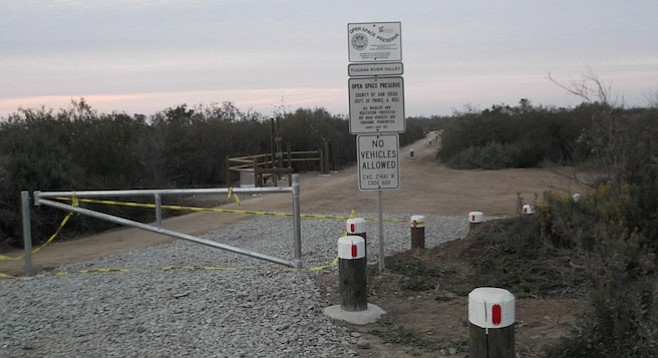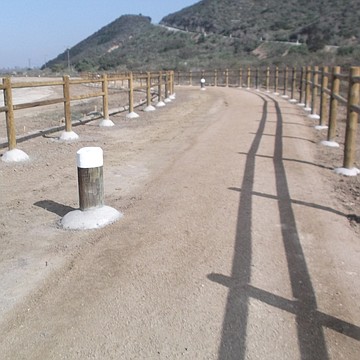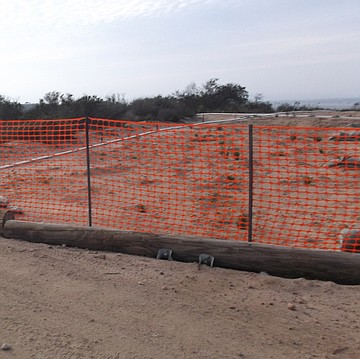 Facebook
Facebook
 X
X
 Instagram
Instagram
 TikTok
TikTok
 Youtube
Youtube

As a finishing touch to an $8.4 million project next to the U.S.-Mexico border in Tijuana River Valley Regional Park, the county is installing low poles called bollards down the middle of trails and putting gates across the entrances to some of them.

“Those things are going to make it harder and more dangerous for us to do our job,” says National Border Patrol Council spokesman Gabe Pacheco, with Local 1613. “And we’re going to get injured.”


Pacheco, an active-duty Border Patrol agent, was speaking as the union’s certified safety officer. He said federal agents at the Imperial Beach station have already had to take illegal crossers to the hospital after they were injured by some of the telephone poles and rebar placed in the brush atop the mesas. County contractors put the obstacles in as part of the closing off of the trails.
The county park project is based on a plan and environmental impact report that was completed and approved in 2006. At the time, the Border Patrol reviewed and signed off on it.
The plan is meant to consolidate about 70 miles of official and unofficial trails into 22.5 miles of trail for horses, bikes, and people, including new trails on the high mesa east of Smuggler’s Gulch.
But, Pacheco said, the 2006 plan didn’t include placing dozens of bollards down the middle of the dirt trails the Border Patrol uses the most and fencing off entire sections of new trail.
“These things are dangerous — when we’re in pursuit, the vehicles kick up a lot of dirt. We have visibility problems in fog and at night,” said Pacheco. “Put that all together and it’s a matter of time before our agents get hurt for trying do their jobs,” he said.
Mike Verderber, the supervising park ranger at the park, said the bollards have white paint at the top and reflectors attached to them for safety.
“The philosophy of the bollards would be that would define the park and recreation side of the road and define an area for the Border Patrol to continue their dragging,” Verderber said in a message. “We’re going to provide them with a map of the bollards.”
Equestrians and hikers have a mixed reaction to the bollards. The Tijuana River Valley Equestrian Association has not reached a consensus on them. Some riders feel the bollards mean Border Patrol agents will drive slower and their horses are less likely to be frightened. Others say that if the horses are frightened, the bollards become a danger to the horse and rider as well.
New fences and bollards also block access to areas where many of the illegal crossers are caught, Pacheco said. And the county has installed iron gates to block vehicles across at least two entrances to the trails north of Monument Road.
“There are places now where an agent will either have to drive a half mile around or chase groups on foot,” Pacheco said. “Imperial Beach has a high percentage of felons deported from U.S. prisons coming back across here and we don’t have a minute to spare — they need just a little advantage and they can get to I.B. or San Ysidro or to the pick-up point, and they’ve gotten though.”
The county’s costs for maintaining roads and trails in the area are higher than usual because of the Border Patrol’s traffic and its practice of “dragging” the roads with tires several times a day to wipe them clean of old footprints and tire marks so they can track new traffic.
Pacheco acknowledges that the agents make a mess doing their job but says that the local station worked with the state park, recently completing a project to fill and repair the roads they use in that park.
“It’s ironic that we have made this park safe for more people to come here and their response is to make our job more difficult and put our people in harm’s way,” he said.
The author is a regular hiker in the Tijuana River Valley state and county parks and appreciates the efforts of both the San Diego County Parks and Recreation Department and the U.S. Border Patrol.


As a finishing touch to an $8.4 million project next to the U.S.-Mexico border in Tijuana River Valley Regional Park, the county is installing low poles called bollards down the middle of trails and putting gates across the entrances to some of them.

“Those things are going to make it harder and more dangerous for us to do our job,” says National Border Patrol Council spokesman Gabe Pacheco, with Local 1613. “And we’re going to get injured.”


Pacheco, an active-duty Border Patrol agent, was speaking as the union’s certified safety officer. He said federal agents at the Imperial Beach station have already had to take illegal crossers to the hospital after they were injured by some of the telephone poles and rebar placed in the brush atop the mesas. County contractors put the obstacles in as part of the closing off of the trails.
The county park project is based on a plan and environmental impact report that was completed and approved in 2006. At the time, the Border Patrol reviewed and signed off on it.
The plan is meant to consolidate about 70 miles of official and unofficial trails into 22.5 miles of trail for horses, bikes, and people, including new trails on the high mesa east of Smuggler’s Gulch.
But, Pacheco said, the 2006 plan didn’t include placing dozens of bollards down the middle of the dirt trails the Border Patrol uses the most and fencing off entire sections of new trail.
“These things are dangerous — when we’re in pursuit, the vehicles kick up a lot of dirt. We have visibility problems in fog and at night,” said Pacheco. “Put that all together and it’s a matter of time before our agents get hurt for trying do their jobs,” he said.
Mike Verderber, the supervising park ranger at the park, said the bollards have white paint at the top and reflectors attached to them for safety.
“The philosophy of the bollards would be that would define the park and recreation side of the road and define an area for the Border Patrol to continue their dragging,” Verderber said in a message. “We’re going to provide them with a map of the bollards.”
Equestrians and hikers have a mixed reaction to the bollards. The Tijuana River Valley Equestrian Association has not reached a consensus on them. Some riders feel the bollards mean Border Patrol agents will drive slower and their horses are less likely to be frightened. Others say that if the horses are frightened, the bollards become a danger to the horse and rider as well.
New fences and bollards also block access to areas where many of the illegal crossers are caught, Pacheco said. And the county has installed iron gates to block vehicles across at least two entrances to the trails north of Monument Road.
“There are places now where an agent will either have to drive a half mile around or chase groups on foot,” Pacheco said. “Imperial Beach has a high percentage of felons deported from U.S. prisons coming back across here and we don’t have a minute to spare — they need just a little advantage and they can get to I.B. or San Ysidro or to the pick-up point, and they’ve gotten though.”
The county’s costs for maintaining roads and trails in the area are higher than usual because of the Border Patrol’s traffic and its practice of “dragging” the roads with tires several times a day to wipe them clean of old footprints and tire marks so they can track new traffic.
Pacheco acknowledges that the agents make a mess doing their job but says that the local station worked with the state park, recently completing a project to fill and repair the roads they use in that park.
“It’s ironic that we have made this park safe for more people to come here and their response is to make our job more difficult and put our people in harm’s way,” he said.
The author is a regular hiker in the Tijuana River Valley state and county parks and appreciates the efforts of both the San Diego County Parks and Recreation Department and the U.S. Border Patrol.
Comments